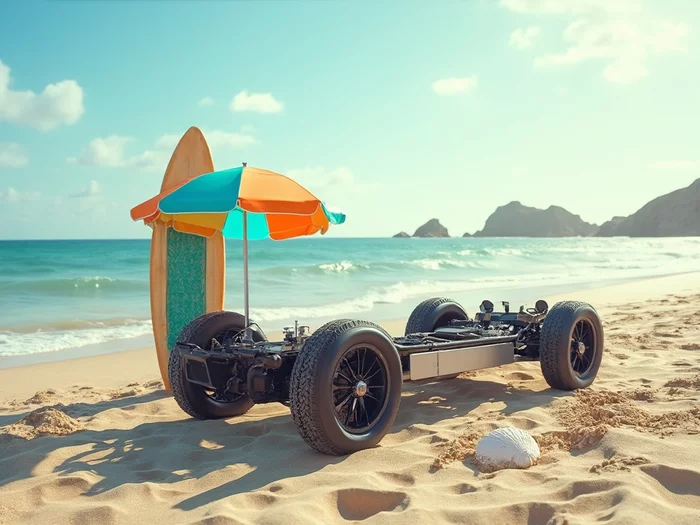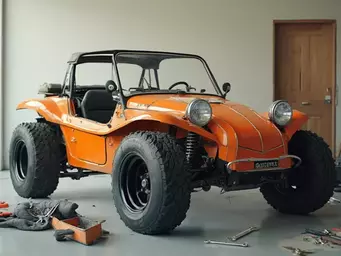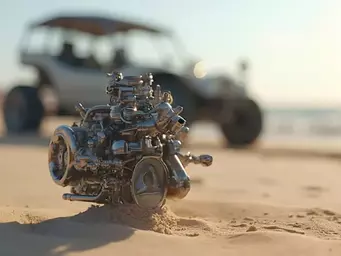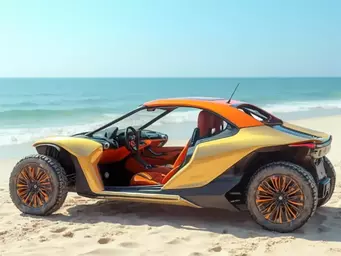VW Type 1 (Beetle) Chassis
**Characteristics:** Lightweight, Versatile, Common
- Ideal For: Performance, agility
- Build Goal: Casual driving, off-road (modified)
Get the latest beach buggy build guides, restoration tips, and performance upgrades delivered directly to you.
Posted on: 2025-10-13
By: Jasper Quinn
Building your dream beach buggy starts with the right foundation! Did you know that the choice of chassis can significantly impact performance and aesthetics? Let's explore the essential insights to guide your decision-making process.
This visual outlines the key Volkswagen chassis options for beach buggy builds, categorized by their primary characteristics and suitability for different project goals.
Welcome to the exciting journey of building your very own beach buggy! As an automotive enthusiast, I know that the chassis you choose can set the stage for your entire project. At Beach Buggy Builders, we’re here to help you navigate through the different types of Volkswagen chassis available, ensuring you make an informed choice that aligns with your beach buggy dreams!
Let’s dive into the Volkswagen chassis landscape and explore what makes each option unique and suitable for your build.
Volkswagen has a rich history of producing various chassis types that have become the foundation for countless beach buggies. The most popular choice is undoubtedly the VW Beetle chassis, known for its lightweight structure and versatility. For a deeper understanding of Volkswagen's engineering, including their various chassis and transmissions, you can refer to the official Volkswagen Newsroom. Other notable options include the VW Type 2, which is a bit heftier, making it perfect for those looking to build a larger buggy.
Understanding the characteristics of each chassis will help you decide what fits best with your vision. Whether you want to cruise the beach or tackle rugged terrain, there’s a VW chassis that can meet your needs!
When it comes to beach buggy builds, you have several VW chassis options to consider. The VW Type 1 (Beetle) is the most common choice, offering a solid base for customization. It’s lightweight and provides great performance on sand!
On the other hand, the VW Type 2 (Transporter) chassis is ideal if you're aiming for a larger buggy, offering more space for passengers and gear. If you’re looking for something a bit more unique, the VW Karmann Ghia chassis offers a sleek design that stands apart.
Each chassis has its own set of advantages, so think about what features matter most to you as you plan your build!
Before diving into the technical aspects, it’s essential to define the purpose of your beach buggy. Are you looking for something just for casual driving along the coast, or do you plan to tackle some serious off-road adventures? Perhaps you want a showstopper to display at local car shows?
Understanding your goals will guide your decisions on chassis selection and modifications. It’s important to align your chassis choice with your intended use to ensure you get the most out of your build.
Having a clear vision will not only make the build process more enjoyable but also ensure that your finished buggy meets your expectations!
When choosing a chassis, it's crucial to assess its condition carefully. Look for common signs of wear, such as rust and structural integrity issues. Rust can be a dealbreaker, especially in critical areas, so be thorough in your inspection!
Here are some key checkpoints to consider when evaluating a VW chassis:
Taking the time to evaluate these factors will save you headaches later on and help you find a solid foundation for your beach buggy project.
As you dive deeper into your beach buggy journey, analyzing different VW chassis models and years can provide valuable insights into what will work best for you. Each model and year has its unique characteristics that can affect your build.
For instance, later models typically come with improved engineering and features. However, earlier models can offer simplicity, which might be beneficial for beginners:
Understanding the pros and cons of each model will help you choose a chassis that best fits your build and budget!
Once you've selected your chassis, it's time to consider the modifications necessary to transform it into a beach buggy. The most common modification is shortening the chassis to achieve the ideal length for optimal handling and appearance.
Other essential modifications include:
These modifications not only enhance performance but also ensure your buggy is safe for all your beach adventures.
To elevate your beach buggy to new heights, consider various performance upgrades. These enhancements can significantly improve your buggy's handling and speed on sandy terrain.
Some popular upgrades include:
With the right upgrades, your beach buggy can handle whatever the coastline throws at you!
One of the key considerations when building your beach buggy is ensuring parts compatibility. Not all parts will fit seamlessly, so it's essential to do your research. Many aftermarket suppliers offer components specifically designed for beach buggy builds.
To make your sourcing easier, here are some tips:
Thinking ahead about parts compatibility will streamline your building process, making the entire experience more enjoyable!
As with any project, budgeting is crucial for a successful beach buggy build. Consider all your costs, including chassis acquisition, parts, and modifications. A well-planned budget can help you stay on track and avoid unexpected expenses.
Here are some budgeting tips to help you get started:
Being mindful of your finances at the beginning can lead to a smoother and more enjoyable build process!
Finally, it’s essential to understand the safety and legal aspects of building a beach buggy. Depending on your location, modified vehicles may have specific registration and safety requirements. For example, in California, you might need to consult resources like the California Air Resources Board (CARB) for information on vehicle modification regulations. Additionally, for broader context on vehicle compliance and environmental standards, the EPA's FAQs on the VW Mitigation Trust can offer insights into relevant regulations. Ensuring compliance not only keeps you safe but also helps you avoid potential legal issues.
Here are some key considerations:
Taking these factors into account will help ensure that your beach buggy is not only fun but also safe and legal on the roads!
To make your decision-making process easier, consider using visual aids like checklists and decision trees. These tools can help you evaluate chassis options and modifications more effectively.
For example, a checklist might include:
Using visual aids can streamline your decision-making process and ensure you make the best choices for your beach buggy project!
When inspecting a VW chassis for your beach buggy, don't just focus on the obvious signs of wear like rust. Pay close attention to the condition of the suspension components and any modifications made in the past. A well-maintained chassis, even if it's older, can often outperform a newer one that hasn't been cared for properly. Always ask the seller for maintenance records to get a complete picture of the chassis' history!
Congratulations on taking the first steps toward building your very own beach buggy! The journey can be thrilling, and it all starts with choosing the right chassis. Now that you have a better understanding of Volkswagen chassis and their unique characteristics, it's time to focus on the next steps. Whether you’re acquiring a chassis, planning modifications, or gathering parts, let’s dive into what you can do next!
To further your knowledge and skills, there’s a treasure trove of resources available. I've compiled a list of valuable links where you can find additional guides, videos, and forums tailored to beach buggy enthusiasts:
These resources can provide you with insights and support as you embark on your beach buggy journey, so don't hesitate to explore them!
The passion for beach buggies goes beyond individual projects; it's about community! I invite you to connect with fellow enthusiasts who share your love for these vehicles. You can join local clubs or online forums where you can:
Being part of a community can make your journey even more enjoyable and fulfilling. Plus, you’ll find inspiration in the success stories of others who have taken the plunge!
As we wrap up this section, remember that choosing the right chassis is pivotal to bringing your beach buggy vision to life. Take your time to weigh the options and consider the type of build that excites you the most. Think about your goals and how each chassis can align with them. This thoughtful approach will result in a build that not only meets your needs but also reflects your personal style.
Once you've built your beach buggy, maintenance will play a crucial role in ensuring its longevity and performance. Here are some practical tips to keep your buggy in top shape:
By staying on top of maintenance, you’ll enjoy many fun-filled days on the beach, knowing that your hard work and dedication have paid off!
Here is a quick recap of the important points discussed in the article:

 What if every turn of the wrench not only transformed your beach buggy but also deepened your passio
What if every turn of the wrench not only transformed your beach buggy but also deepened your passio
 Upgrading your beach buggy isn't just about power—it's a journey towards better performance and en
Upgrading your beach buggy isn't just about power—it's a journey towards better performance and en
 Have you ever felt the thrill of cruising along the shore in a custom beach buggy, the sun warming y
Have you ever felt the thrill of cruising along the shore in a custom beach buggy, the sun warming y